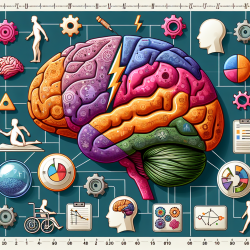Introduction
Traumatic Brain Injury (TBI) presents a complex challenge to rehabilitation professionals due to its diverse and persistent effects on both cognitive and motor functions. Recent research, particularly the study titled Relationship Between Cognition and Gait at 2- and 12-Months Post-Traumatic Brain Injury, offers valuable insights into the interconnectedness of these domains. This blog aims to explore how practitioners can leverage these findings to enhance rehabilitation outcomes for individuals with TBI.
Understanding the Study
The study conducted by Vuong et al. (2021) analyzed the relationship between cognitive function and gait recovery in 93 participants with TBI. The researchers utilized spatiotemporal gait variables and cognitive assessments, such as the Trail Making Test-B (TMT-B) and Digit Span-Forward (DS-F), to evaluate recovery at 2 and 12 months post-injury.
Key findings include significant correlations between early cognitive performance and long-term gait outcomes. Specifically, TMT-B scores at 2 months post-injury were predictive of gait variability and velocity at 12 months. These results suggest that cognitive function, particularly executive function, plays a crucial role in motor recovery post-TBI.
Implications for Practice
The study's findings underscore the importance of integrating cognitive and motor rehabilitation strategies. Practitioners can enhance outcomes by:
- Adopting a Holistic Approach: Rehabilitation programs should incorporate both cognitive and motor exercises. This integrated approach can address the interconnected pathways affected by TBI, potentially leading to more comprehensive recovery.
- Utilizing Predictive Assessments: Cognitive assessments like TMT-B can serve as valuable tools for predicting motor recovery. Practitioners can use these assessments to tailor rehabilitation plans and set realistic goals.
- Emphasizing Early Intervention: Early cognitive rehabilitation may enhance long-term motor outcomes. Initiating cognitive exercises soon after injury can support neural recovery and improve gait function over time.
Encouraging Further Research
While the study provides promising insights, further research is needed to refine rehabilitation strategies. Future studies could explore:
- Dual-Task Training: Investigating the efficacy of simultaneous cognitive and motor training could provide deeper insights into optimizing rehabilitation protocols.
- Neural Internetwork Models: Exploring the neural pathways that link cognition and motor function can enhance our understanding of TBI recovery mechanisms.
- Longitudinal Studies: Extended follow-up studies could offer more comprehensive data on the long-term impacts of integrated rehabilitation approaches.
Conclusion
Integrating cognitive and motor rehabilitation presents a promising avenue for improving outcomes in individuals with TBI. By leveraging the predictive power of cognitive assessments and adopting a holistic approach, practitioners can enhance recovery and quality of life for their patients. To delve deeper into the original research, please follow this link: Relationship Between Cognition and Gait at 2- and 12-Months Post-Traumatic Brain Injury.










